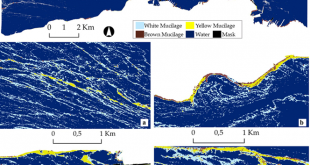Fresenius Environmental Bulletin Journal, 26(1), 196-203 (2017)
Recent Satellite Technologies for Soil Salinity Assessment with Special Focus on Mediterranean Countries
Gorji, T., Sertel, E., Tanik, A.
Abstract: Recent satellite technologies for soil salinity assessment with special focus on Mediterranean countries Gorji Taha1, Sertel Elif2, Tanik Aysegul1 1Faculty of Civil Engineering, Department of Environmental Engineering,Istanbul Technical University, Istanbul, Turkey 2Faculty of Civil Engineering, Department of Geomatics Engineering,Istanbul Technical University, Istanbul, Turkey Soil salinization is one of the most important phenomena accelerating the land degradation processes which in turn cause loss of soil productivity and reduction in biomass production. Due to high spatial and temporal variability of soil salinity, mapping and tracking its changes is an essential issue for anticipating natural disaster like desertification and for mitigating severe economic and social consequences in especially arid and semi-arid regions of the world. Over the past few decades, remote sensing technologies highly contribute to rapid and accurate soil salinity assessments. These approaches are fast, non-destructive and can potentially be used to map topsoil salinity after conducting digital image processing techniques. Multispectral and particularly, hyperspectral remotely sensed data are an important source for monitoring soil salt content on a large scale. Provision of a relatively cheap multispectral data at short, repeated intervals has allowed detecting changes in soil salinity and assessing its speed of occurrence. In previous studies, barriers such as interference due to the presence of vegetation restricted the precision of mapping salinity; however, more recent studies tested some new methods for predicting soil salinity with improved precision by using hyperspectral data. The knowledge and data gained from remote sensing of saline soils is highly utilized as a part of worldwide agricultural activities. Prevailing climatic conditions alongside using old irrigation technologies in the Mediterranean countries put forward the common soil salinity problem. Remotely sensed images taken over a period of time are used to monitor the advancement of the reclamation projects in these countries to ensure that the processes are being carried out appropriately and that the soil is being returned to its original condition and to predict areas at risk. The main objective of this study is to review the most recent remote sensing applications for soil salinity assessment via various multispectral data, such as LANDSAT, Moderate Resolution Imaging Spectroradiometer (MODIS), SPOT, IKONOS, Quick Bird and the Indian Remote Sensing (IRS) series of satellites, as well as hyperspectral data such as HuanJing (HJ)-HSI and Hyperion EarthObserving 1 (EO-1). Furthermore, utility of recent remote sensing analysing techniques and methods including linear spectral unmixing, supervised maximum likelihood classification, visual image analysis, Guassian maximum likelihood algorithm, principal components analysis, inverted Gaussian function, partial least square regression technique, data mining techniques, multiyear maxima and multi-scale modelling, artificial neural network and regression–kriging approaches will be discussed in the full manuscript. Examples of the temporal and spatial changes in salt- affected Mediterranean soils will be referred. In addition, various spectral bands which are sensitive to soil salinity for each multispectral data will be introduced and also explanations will be given about the generation of salinity and vegetation indices by combining appropriate spectral bands in order to achieve most significant correlation with ground electrical conductivity values.

Available Online:
 UHUZAM İTÜ – Uydu Haberleşme ve Uzaktan Algılama UYG-AR Merkezi
UHUZAM İTÜ – Uydu Haberleşme ve Uzaktan Algılama UYG-AR Merkezi 